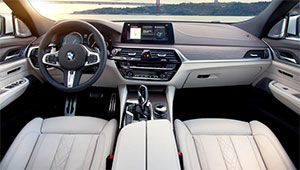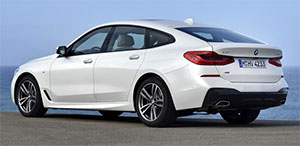2018 BMW 640i Gran Turismo
BMW seems to on a mission to be all things to all people…or at all least to all luxury car buyers. So, in addition to being early adopters to the luxury SUV game, they’re now trying to fill every niche possible, including ones that only they seem to be competing in. Well, maybe that explains the 6 Series Gran Turismo; let’s see if there is a method to their marketing madness.
It’s hard to classify the 2018 BMW 640i xDrive Gran Turismo. It’s certainly not your typical sedan or hatchback; and don’t confuse it with the 6 Series Gran Coupe either. But, if you remember the 5 Series GT from 2010, think of this 640 GT as its replacement; or perhaps the closest thing to a 5-series wagon that we’re likely to get here in the states.
And like its predecessor, there’s an enormous amount of space inside, thanks to a 120.9-inch wheelbase that’s almost 4-inches longer than a 5 Series sedan.
It’s still a far cry from beautiful, but the design appears much more cohesive than before. The rear remains tall; but in profile, it now looks more like a traditional 5-door hatchback, and less like a truncated wagon.
 The aggressive nose, and lots of taut body lines, are all BMW hallmarks, and BMW continues to have some of the coolest headlights out there. Standard wheels are 19s.
The aggressive nose, and lots of taut body lines, are all BMW hallmarks, and BMW continues to have some of the coolest headlights out there. Standard wheels are 19s.
You’ll enjoy all of the roominess no matter which seat you find yourself in.
Those up front will also experience the typical BMW sporty cockpit feel; while those in back, will get full-size sedan amounts of legroom and headroom.
Interior design is similar to the 5 Series and just about every other BMW for that matter; high quality materials, large dash-top mounted infotainment screen, iDrive controller, electronic shifter, shift paddles on the wheel, rudimentary manual controls, and great looking wood trim.
And of course available niceties such as a head-up display, soft close doors, 3D surround view, heated seats and steering wheel, panoramic moonroof, and even remote control parking.
 Under the power-operated rear hatch is a very wide opening, and 31.0 cubic-ft. of nicely finished space. Folding the seatbacks, ups it to 65.0 cubic-ft. Even though the swoopy roof will cut into cargo height, capacity is directly in between BMW’s X3 and X5 Sports Activity Vehicles, and more than the bulbous looking X6.
Under the power-operated rear hatch is a very wide opening, and 31.0 cubic-ft. of nicely finished space. Folding the seatbacks, ups it to 65.0 cubic-ft. Even though the swoopy roof will cut into cargo height, capacity is directly in between BMW’s X3 and X5 Sports Activity Vehicles, and more than the bulbous looking X6.
Much like the 5 Series, it has the perfect balance of luxury and sportiness. Want to relax and cruise on the highway? It does that with true tranquility and silkiness. Want to whip it around your favorite back road? No problems there either; it stays very flat and responds immediately to every input.
Though our car was aided by the available Dynamic Handling Package, which adds Active Roll Stabilization and Integral Active Steering to the Dynamic Damper Control air suspension. It all works together to make the Gran Turismo’s 4,400-lbs. all but disappear through high speed sweepers.
The experience however was slightly different through our tight cone course. Here, the steering feels over-boosted, and we wished for more feedback from all parts of the car. Yet, grip remained fantastic throughout.
 There was traction a-plenty for launching as well; and a launch mode that worked flawlessly, getting us to 60 in just 4.8-seconds.
There was traction a-plenty for launching as well; and a launch mode that worked flawlessly, getting us to 60 in just 4.8-seconds.
Power pours on strong, and never lets up; despite a bit of a see-saw weight-transfer effect when the 8-speed automatic transmission triggers a shift. And a healthy bellow from the exhaust accompanied us for the entire 13.3-second trip through the ¼-mile, at which time we were travelling at 105 miles-per-hour.
Making all of this happen, is BMW’s 3.0-liter inline-6 turbo engine; rated at 335-horsepower and 332 lb-ft. of torque. All-wheel-drive is standard.
There’s plenty of whoa to go along with the go. 99-feet was our average stopping distance from 60. We did experience some fade as the runs added up, but there is an awful lot of weight to bring to a stop that quickly.
Government Fuel Economy Ratings are 20-City, 28-Highway, and 23-Combined. Our average on Premium was just about right on, at 23.2 miles-per-gallon. Making for an average Energy Impact Score, with yearly use of 14.3-barrels of oil, and C02 emissions of 6.4-tons.
Things are as simple as it gets when it comes to pricing; just one version of the Gran Turismo, starting at $71,195, to which you can add a host of options, either in package form or a la carte.
Well, if you were looking for a very luxurious ride with plenty of comfort and performance, there were already plenty of BMWs to choose from. Now you can add one more to the list, the 2018 BMW 640i xDrive Gran Turismo. It is the best of BMW sedans, SUVs, and hatchbacks, all rolled into one. We agree that the brand may indeed be slicing the marketing onion super thin, but if that means competing in a class of one, no one does it better than BMW
Specifications
- Engine: 3.0 liter
- Horsepower: 335
- Torque: 332 lb-ft.
- 0-60 mph: 4.8 seconds
- 1/4 mile: 13.3 seconds @ 105 mph
- EPA: 20 mpg city / 28 mpg highway
- Energy Impact: 14.3 barrels of oil/yr
- CO2 Emissions: 6.4 tons/yr
2025 Volkswagen ID. Buzz
Volkswagen Brings Beetlemania Level Of Excitement To Minivan Segment
The duty of upholding Volkswagen’s heritage has most recently been delegated to small legacy car names like Golf and Jetta. But hold on! A much larger, totally modern take on VW’s classic microbus has just buzzed over the horizon— the all-electric ID. Buzz. It’s been at the top of our minds since we first saw the concept back in 2017. Well, it’s finally here, so let’s get our groove into drive!
This 2025 Volkswagen ID. Buzz has indeed created the most buzz around Volkswagen since the Beetle’s return to the U.S. in the late 1990s. We couldn’t drive it anywhere without drawing a crowd. No wonder, just about everyone has a VW Microbus story to tell, and seeing this reimagined version rolling down the street brings back all those memories.
VW really pulled it off as far as we’re concerned, as it looks great without appearing over the top. All the cues are here: Big VW logo front and center, lots of greenhouse including A-pillar windows and mini sliders for the second-row passengers, D-pillar air vents, and two-tone wheels. And while its appearance may be pure retro, its drivetrain is far from it, as the ID. Buzz is all-electric, and unlike the new Beetle, the Buzz does retain the original Microbus’ rear-drive architecture.
Powering those rear wheels is a 210-kW motor drawing juice from a 91-kWh battery for a range of 234 miles; 200-kW max charging will get you to 80% in about 26 minutes. Buyers can add another small 80-kW motor up front for 4motion all-wheel-drive and an increase of total output from 282 to 335 horsepower with a combined 512 lb-ft of torque. It uses the same battery, but range estimates drop just slightly to 231 miles. But while those numbers are modest, we also found them to be quite conservative, as we observed as many as 287 miles available in our all-wheel-drive tester’s gauge display and were on pace for 273 miles in our driving loop.
One throwback theme that may be a turnoff to some is that it’s quite a step up into the Buzz’s front seats, but there’s certainly a commanding view of the road once you climb in. Second row seating can be either a three-place bench or a pair of captain’s chairs, so there’s generous room for seven or six passengers. The captain’s chairs in our Pro S Plus offer good support and very easy access to the third row.
Lots of flexibility too with the option to simply fold the seats or remove them altogether.
With the sliding side doors and a wide opening rear hatch, there’s plenty of access for loading big sport utility amounts of cargo. Lots of flexibility too with the option to simply fold the seats or remove them altogether, and the ability to create a full-length flat floor with a rear cargo shelf that covers some handy removable storage bins. There’s 18.6 cubic-feet of space behind the third row, 75.5 behind the second, and a max of 145.5. That’s more than a Chevrolet Tahoe. For smaller items, there are lots of cubbies throughout the cabin, along with a standard Buzz Box that can be moved to multiple locations.
With a design that prioritizes retro form and modern function over aero efficiency, the 4motion equipped ID. Buzz earns a Fair efficiency rating, using 42-kWh of electricity per 100 miles, and we weren’t sure what to expect at our Mason Dixon test track.
What we found was great torque off the line and drama free launches to 60 in just 5.3 seconds. It was very stable at speed and power delivery stayed steady most of the way down the track until we reached about 90 mph, when it began to taper off just before we finished the quarter-mile in 14.0 seconds flat at 97 mph.
With 1,200-lbs. of battery weight nestled in its 127.5-inch wheelbase, the Buzz felt planted to the pavement through our handling course. There was quite a bit of body roll to deal with, but surprisingly little understeer. In panic braking runs, pedal response was inconsistent, feeling soft at times, pushing back hard at others; but through it all, results were quite good, stopping from 60 in an average of just 108 feet.
Three interior themes are available, this Dune is the brightest, featuring coastal inspired wood optic dash décor, “gray and clay” leatherette surfaces, and a high-mounted central 12.9-inch touchscreen. Pricing starts with a rear-wheel-drive Pro S at $61,545; this Pro S Plus begins at $65,045, add another $4,500 for 4motion, which brings a few extra features along with all-wheel drive.
Retro design with old-school VW charm, modern EV drivetrain, big SUV capacity merged with minivan flexibility; it all comes together in this 2025 Volkswagen ID. Buzz. It’s easily one of the coolest rides of the year and one that will likely keep Volkswagen dealers buzzing for years to come, and that’s something no other people and things mover can say.
Specifications
As Tested
- Motor Setup: Dual-Motor AWD
- Battery Size: 91-kWh
- Horsepower: 335
- Torque: 512 lb-ft
- EPA Range: 231 miles
- 0-60 mph: 5.3 seconds
- 1/4 Mile: 14.0 seconds at 97 mph
- Braking, 60-0: 108 feet
- MW Test Loop: ~ 273 miles













































